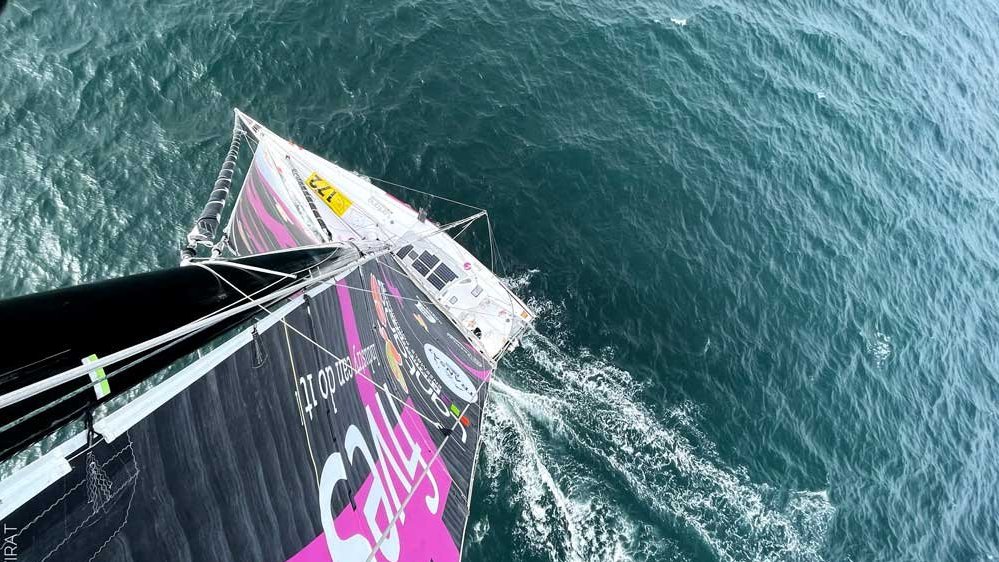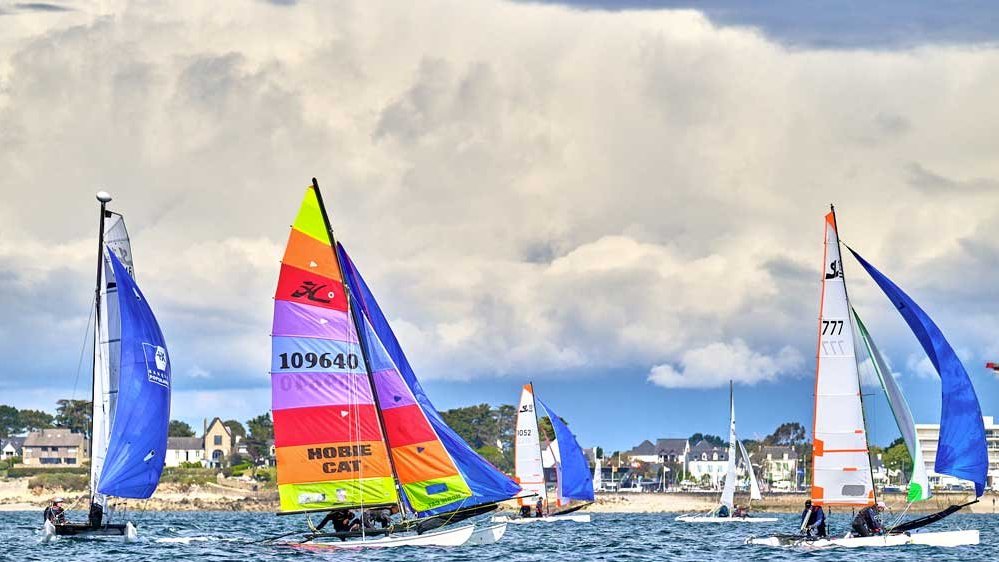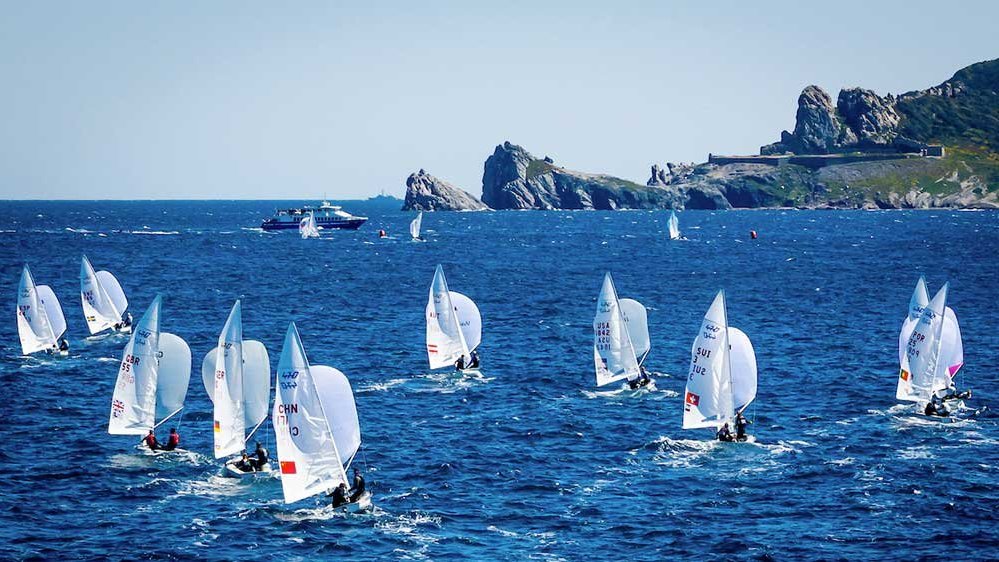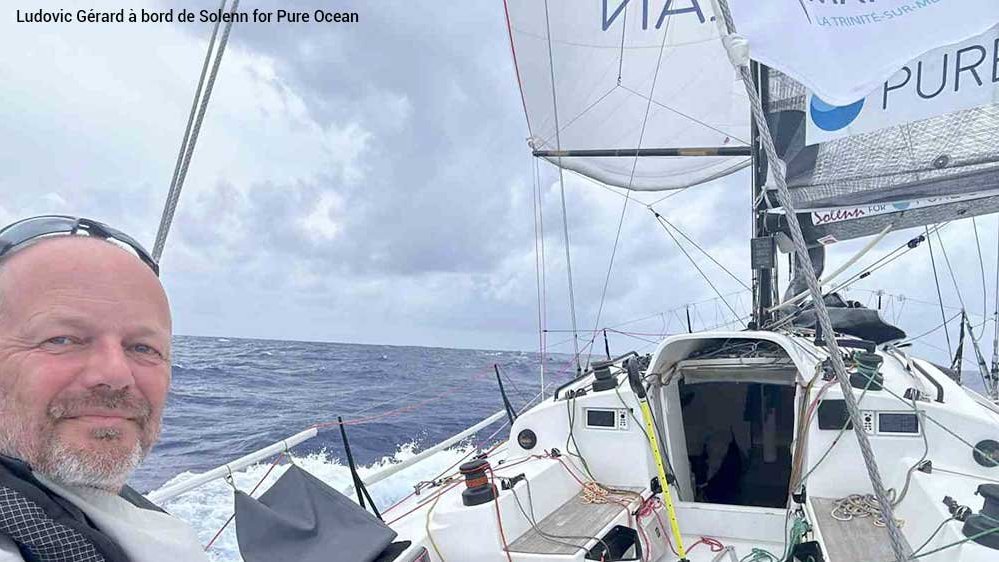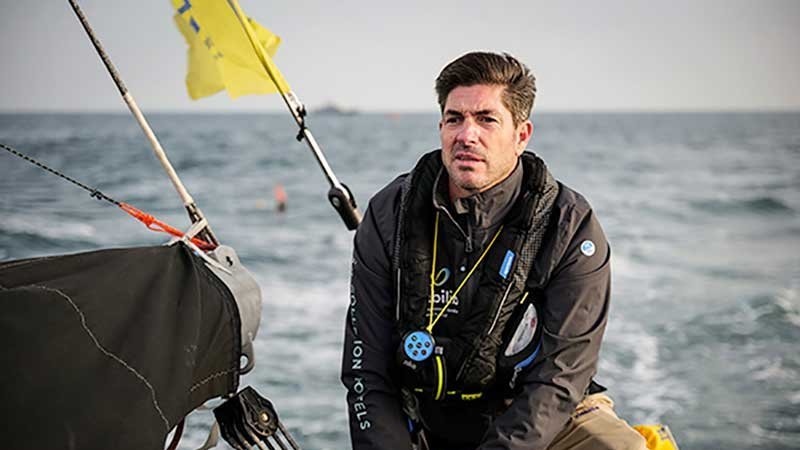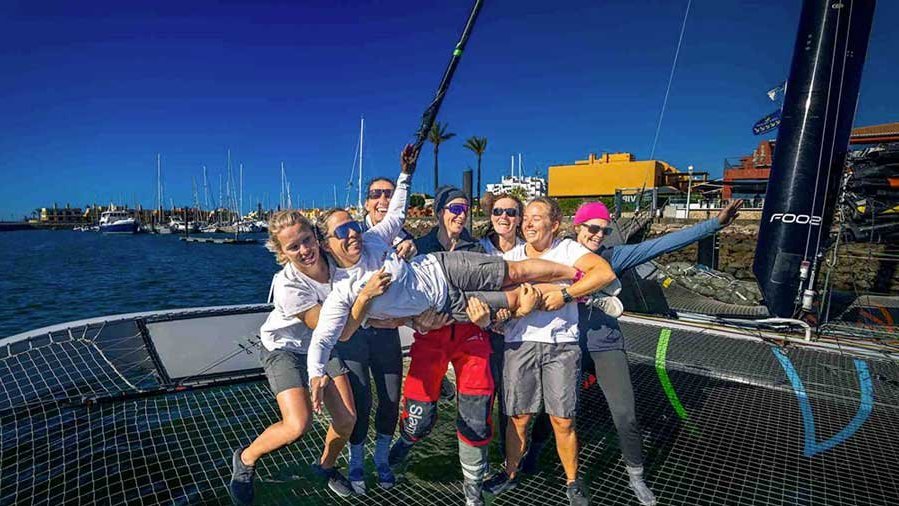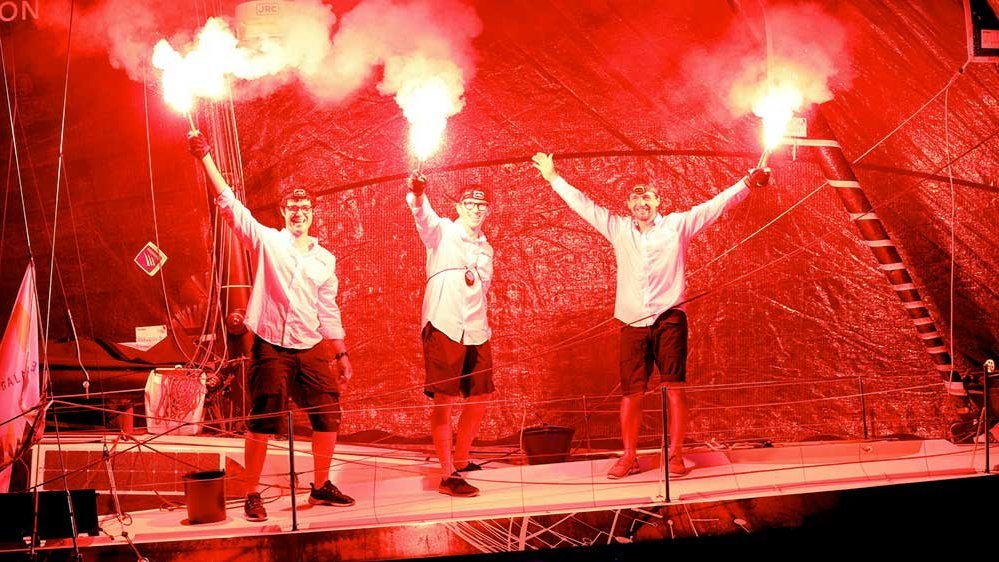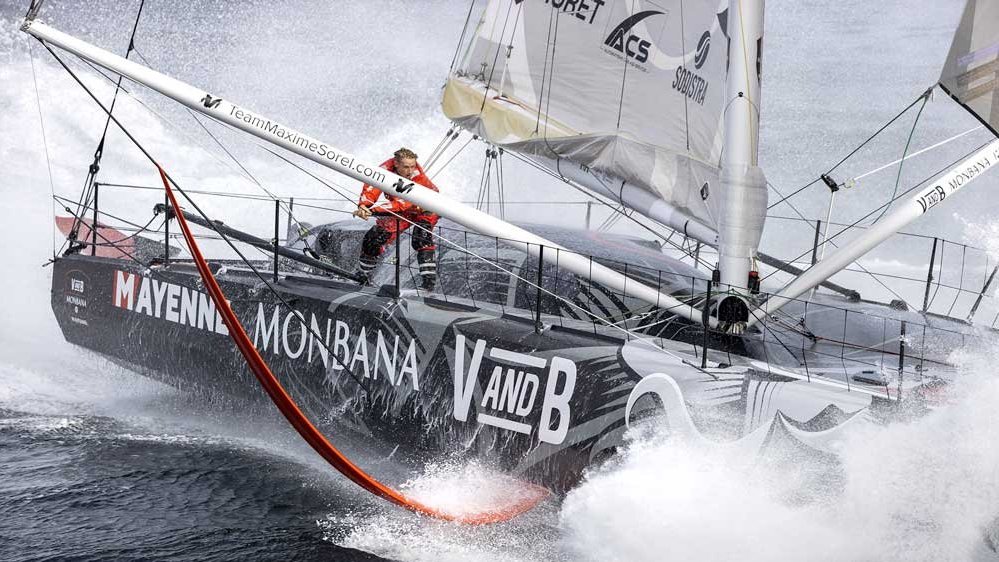Vendée Globe
Nick Moloney : "I’m gutted, completely devastated, half of me is just shattered"
Australian skipper lost his keel miles from Rio 80% trough the race
mercredi 26 janvier 2005 –
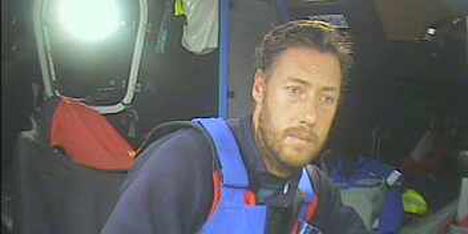
- Nick Moloney aboard Skandia on January 6th
- Photo : N.Moloney / Skandia
Nick is unharmed, and safe onboard Skandia and dealing with the situation as best he can. “I’m alright, but I’m gutted and completely devastated. Half of me is just shattered and the other half of me is very relieved that we’re still upright, and that this didn’t happen in the south. I’m really really shattered but I am so focused on just trying to fight back you know. And that’s my occupation right at the moment, to try and keep this situation under control. I was saying to Conrad [skipper of Hellomoto, also in the race] when we were in the Indian Ocean that in proportion of our projects we’re 95% of the way there. When you talk about all the work and all the planning and all the dreaming and all the effort that goes in to do this, we’re not 80% through the race, we’re 99.9% of the way to the finish and for me everything was safe and I felt like I was making some reasonable decisions. In the past few days I felt like I was getting closer, I’ve been talking to my family and friends talking about what’s happening afterwards and what we’re going to do and how great it’s going be and my head was going home. And now it’s all over.”
The keel of Skandia was a conservative, well tried and tested design, an evolution in terms of safety of the same type of keel used in the last Vendée Globe when the boat competed as ‘Kingfisher’ with Ellen MacArthur as skipper. A collision with an unknown object one week ago could have been a contributary factor, but it will be difficult to provide any further explanations before a more complete inspection. The keel was well within its safe mileage, having been replaced for the Route du Rhum Route du Rhum #RouteDuRhum race in 2002. Further details below.
Moloney was on day 80 of the Vendée Globe with under 5,000 miles left to go on the solo round the world course. It was his first participation in the race and it dramatically ends his long-held dream to complete 3 big round the world sailing goals - of crewed round the world [1997-98 Whitbread on board Toshiba], fastest non-stop round the world [2002 Jules Verne Trophy on board Orange] and, finally, his ultimate goal of solo, non-stop around the world which has now cruelly come to an end.
Interview with Nick Moloney
First thing Nick, how are you ?
![]() I’m alright, you know, like I’m, I’m gutted, completely devastated, half of me is just shattered and the other half of me is very relieved that we’re still upright, and that this didn’t happen in the south.
I’m alright, you know, like I’m, I’m gutted, completely devastated, half of me is just shattered and the other half of me is very relieved that we’re still upright, and that this didn’t happen in the south.
Nick if you could just tell us the order of events and how they happened this morning ?
![]() Well I’ve been struggling to go round this weather system and as I started to see the end of the tunnel, I made my last tack to clear the coast north of Rio, and I tacked about 3 o’clock in the morning. About an hour later I just finished tidying up and sorting everything out. I sat down at the chart table and I started to get some sleep and I heard a bang, it sounded like plastic breaking and I wasn’t terribly concerned and I started trying to drift off to sleep and the boat just started heeling over more and more and as then the boat speed dropped to 4 knots. I went out on deck and I was saying to myself I think we’re going to tip over. I ran down below because I just thought the keel had released because I’ve had a problem with my keel dump switch and I tried to sort it out yesterday and I thought well maybe I’ve pulled out the wrong wire or something and the keel’s dumped to leeward. I went down there and the keel head was the right way and I was looking and I’m thinking, am I tired ? Am I looking at this situation clearly or what ? What’s going on ? And then I tried to de-power and keep sailing and the boat was on it’s ear, completely on it’s ear. I just ran to the windward rail with a torch and I’m trying to look over the side to see the bulb, there were lots of waves breaking over the boat because there was about 25 knots of wind at this stage and quite big waves. I couldn’t see the keel and then I laid on the deck and hung right over the hull and I could see the bulb on the centreline of the boat and I thought oh this is wrong, because it’s gotta be out to the other side. So I went down below and de-powered a bit more, and went down and rang Mark [Turner, Project Director OC] and said I think I’ve broken the keel and we were sort of both talking about it and we both came to the conclusion that’s it couldn’t be possible - and that I must have a big net or something. I couldn’t get the boat speed over 6 knots and the boat was just tipping over, so we got Neil Graham [Technical Director, OC] on the line and Neil said if you are losing your stability there’s a problem with the keel, so get the sails off and just hang out until daylight to have a look. It wasn’t until daylight that I could actually see the fin. I chucked my goggles on and I hung out of the escape hatch in the stern and I looked under the hull and I could see the keel was vertical and swinging, and I obviously knew that wasn’t very good. So I ran back inside and I got the endoscope which is a small 90 degree sight tube and I saw the top, looked like the top foot of the keel was together and then the rest of it was snapped off and hanging down so the top of the fin was 45 degrees which it shouldn’t be with the rams pushing the head over and then the keel’s hanging vertically and swinging. I rang Mark and said the keels broken and it’s gonna come off and I really, really was sure it was gonna come off, so I got the rest of the sails down and filled the ballast tanks to try and stabilise the boat. Then it was just a terrible thing to have to do...to break the seal on the engine and engage the engine and that was it for me - the race was over. Then anyway I couldn’t motor upwind [towards Rio] as the engine kept overheating and we went downwind and we tried dropping the keel on to the centre line, and then soon after it snapped off completely.
Well I’ve been struggling to go round this weather system and as I started to see the end of the tunnel, I made my last tack to clear the coast north of Rio, and I tacked about 3 o’clock in the morning. About an hour later I just finished tidying up and sorting everything out. I sat down at the chart table and I started to get some sleep and I heard a bang, it sounded like plastic breaking and I wasn’t terribly concerned and I started trying to drift off to sleep and the boat just started heeling over more and more and as then the boat speed dropped to 4 knots. I went out on deck and I was saying to myself I think we’re going to tip over. I ran down below because I just thought the keel had released because I’ve had a problem with my keel dump switch and I tried to sort it out yesterday and I thought well maybe I’ve pulled out the wrong wire or something and the keel’s dumped to leeward. I went down there and the keel head was the right way and I was looking and I’m thinking, am I tired ? Am I looking at this situation clearly or what ? What’s going on ? And then I tried to de-power and keep sailing and the boat was on it’s ear, completely on it’s ear. I just ran to the windward rail with a torch and I’m trying to look over the side to see the bulb, there were lots of waves breaking over the boat because there was about 25 knots of wind at this stage and quite big waves. I couldn’t see the keel and then I laid on the deck and hung right over the hull and I could see the bulb on the centreline of the boat and I thought oh this is wrong, because it’s gotta be out to the other side. So I went down below and de-powered a bit more, and went down and rang Mark [Turner, Project Director OC] and said I think I’ve broken the keel and we were sort of both talking about it and we both came to the conclusion that’s it couldn’t be possible - and that I must have a big net or something. I couldn’t get the boat speed over 6 knots and the boat was just tipping over, so we got Neil Graham [Technical Director, OC] on the line and Neil said if you are losing your stability there’s a problem with the keel, so get the sails off and just hang out until daylight to have a look. It wasn’t until daylight that I could actually see the fin. I chucked my goggles on and I hung out of the escape hatch in the stern and I looked under the hull and I could see the keel was vertical and swinging, and I obviously knew that wasn’t very good. So I ran back inside and I got the endoscope which is a small 90 degree sight tube and I saw the top, looked like the top foot of the keel was together and then the rest of it was snapped off and hanging down so the top of the fin was 45 degrees which it shouldn’t be with the rams pushing the head over and then the keel’s hanging vertically and swinging. I rang Mark and said the keels broken and it’s gonna come off and I really, really was sure it was gonna come off, so I got the rest of the sails down and filled the ballast tanks to try and stabilise the boat. Then it was just a terrible thing to have to do...to break the seal on the engine and engage the engine and that was it for me - the race was over. Then anyway I couldn’t motor upwind [towards Rio] as the engine kept overheating and we went downwind and we tried dropping the keel on to the centre line, and then soon after it snapped off completely.
Was there a point Nick when you thought that the boat was in a precarious and dangerous position that you might have to get off ?
![]() Yeah, I had either an oil platform or a fishing boat quite close to me and I wasn’t terribly worried because I’ve seen a lot of boats in the last few days and even in the last few hours, so I wasn’t terribly concerned and the water is warm enough here that your survival rate is quite high. But I love this boat to death and there’s no way I wanna leave it, leave it out in the middle of the ocean you know ? You’ve always got bring them back so, I was pretty focused on the boat staying upright, still am obviously. The situation is still quite dodgy, and I’m just motoring downwind at 4 knots and just trying to keep the boat level, all the weight is obviously on the floor and I’ve got everything that I can down low, and just trying to work it out a bit better. Rob Humphreys design office are on the stability curve of the boat to see what heel angle we’re gonna flip over and the breeze is starting to moderate so things are looking ok for us. It’s a terrible thought to think you might have to leave her. But it’s the second time I’ve felt that in this race and the other time was in the south and I am so so grateful that this situation didn’t unfold in the south.
Yeah, I had either an oil platform or a fishing boat quite close to me and I wasn’t terribly worried because I’ve seen a lot of boats in the last few days and even in the last few hours, so I wasn’t terribly concerned and the water is warm enough here that your survival rate is quite high. But I love this boat to death and there’s no way I wanna leave it, leave it out in the middle of the ocean you know ? You’ve always got bring them back so, I was pretty focused on the boat staying upright, still am obviously. The situation is still quite dodgy, and I’m just motoring downwind at 4 knots and just trying to keep the boat level, all the weight is obviously on the floor and I’ve got everything that I can down low, and just trying to work it out a bit better. Rob Humphreys design office are on the stability curve of the boat to see what heel angle we’re gonna flip over and the breeze is starting to moderate so things are looking ok for us. It’s a terrible thought to think you might have to leave her. But it’s the second time I’ve felt that in this race and the other time was in the south and I am so so grateful that this situation didn’t unfold in the south.
What is the weather ? What is the wave situation like ? You’re talking to your shore team, what is being put in place for the next 24 hours ? When are you going to get back to safety ?
![]() We’re not quite sure yet but the closest coast is Rio but it’s north and it’s about 120 miles away and we’re looking at a few other ports to the west, that are about 160 miles away. And we’re looking at a vessel to come and just stand by with me in case I do go over and potentially a tug to come hook me up and get me in as these [onboard Skandia] engines aren’t really capable of motoring me in.
We’re not quite sure yet but the closest coast is Rio but it’s north and it’s about 120 miles away and we’re looking at a few other ports to the west, that are about 160 miles away. And we’re looking at a vessel to come and just stand by with me in case I do go over and potentially a tug to come hook me up and get me in as these [onboard Skandia] engines aren’t really capable of motoring me in.
Nick, obviously mentally you got round Cape Horn you were heading for home with still a reasonably way to go but 80% of the race completed, how are you coping with it ?
![]() I’m not coping with it to be honest. I’m really really shattered but I so focused on just trying to, like I’ve got a race to fight back you know. And that’s my occupation right at the moment, is to try and keep this situation under control but if I think about the race it just breaks me, completely breaks me. I was saying to Conrad when we were in the Indian ocean in proportions of our project we’re 95% of the way there, you know when you talk about all the work and all the planning and all the dreaming and all the effort that goes in to do this. You know we’re not 80% through the race, we’re 99.9% of the way to the finish and for me everything was safe and I felt like I was making some reasonable decisions, and this was it, I was on my last tack, I was really on my last tack to the trade winds really. I felt every day for the last 5 or 7 days, I’ve just felt like I’m getting closer, I’ve been talking to my family and friends talking about what’s happening afterwards and what we’re gonna do and how great it’s gonna be and my head was going home you know ? And now it’s just ******.
I’m not coping with it to be honest. I’m really really shattered but I so focused on just trying to, like I’ve got a race to fight back you know. And that’s my occupation right at the moment, is to try and keep this situation under control but if I think about the race it just breaks me, completely breaks me. I was saying to Conrad when we were in the Indian ocean in proportions of our project we’re 95% of the way there, you know when you talk about all the work and all the planning and all the dreaming and all the effort that goes in to do this. You know we’re not 80% through the race, we’re 99.9% of the way to the finish and for me everything was safe and I felt like I was making some reasonable decisions, and this was it, I was on my last tack, I was really on my last tack to the trade winds really. I felt every day for the last 5 or 7 days, I’ve just felt like I’m getting closer, I’ve been talking to my family and friends talking about what’s happening afterwards and what we’re gonna do and how great it’s gonna be and my head was going home you know ? And now it’s just ******.
Info Helen King / OC
Voir en ligne : http://www.nickmoloney.com
PRECISIONS ON SKANDIA’S KEEL
The keel of Skandia is made from high tensile steel, to a relatively conservative design by Roger Scammel. In design safety terms, the keel was an evolution from the original keel that was fitted to Skandia in her original configuration as Kingfisher, that successfully completed the Vendée Globe in 2000.
The keel was replaced with a new one for the Route du Rhum at the end of 2002. The boat has since raced the Transat Jacques Vabre and The Transat, and in between each race the keel has been carefully and meticulously inspected. The inspection that was completed successfully in March 2004 including taking the shell plates (the outside skin) off and fully checking the internal structure of the keel visually and with dye penetration tests.
The keel was well within the mileage limit of this type of design and construction. The design and construction of the keel was in no way cutting edge in terms of performance, but rather a solid and well-tested solution. This was the choice of the campaign and skipper, even though lighter and higher performance options were available.
Just over a week ago (night of 17th/18th) Nick suffered a collision which almost brought SKANDIA to a standstill. It was a pretty violent shock, but the keel is designed to withstand this kind of impact, in safety terms if not in terms of performance damaging disfiguration. There is no evidence to suggest there is a link, and at this stage it is not possible to make any clear case for why this has happened. Further inspection on arrival in Brazil may possibly shed more light.
Dans la même rubrique
The 5-Oceans Race : Three legs for the 5-Oceans 2006 race from Bilbao to Fremantle and USA
Vendée Globe : Clean Start to the Single-Handed Loop of the World without stopovers or assistance
1000 milles de Calais : Royal Chess - Brits V “King Jean” in the Open 60 fleet
Défi Atlantique : Gold for Golding in La Rochelle
 Sea, Sail & Surf news
Sea, Sail & Surf news